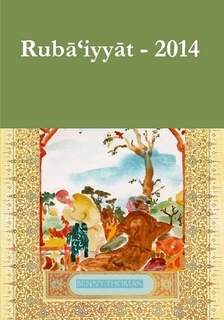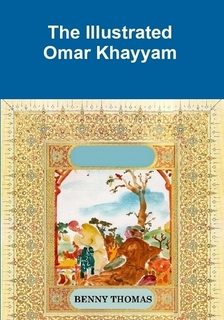 A new version of Khayyám’s quatrains was recently published by Benny Thomas, architect by profession and poet by temperament, in his own words. The work comprises 255 verses, some in rhymes, others only partially rhyming while the rest are blank verses.
A new version of Khayyám’s quatrains was recently published by Benny Thomas, architect by profession and poet by temperament, in his own words. The work comprises 255 verses, some in rhymes, others only partially rhyming while the rest are blank verses.
Thomas’ argument for yet another version or interpretation is that the voice of Omar Khayyam still speaks to us, “because we see in the quatrains our own unexpressed thoughts elegantly phrased”. In his foreword, Aminrazavi describes the quatrains by Benny Thomas as the “silence that makes music of the soul coherent to each”.
Khayyám’s quatrains must not be viewed “as a case for his adherence to Sufi tradition”, nor does the translator’s (that is FitzGerald), skepticism in the quatrains follow from not being true to the original, as Thomas explains. As a mystic he reads something else in them, or to paraphrase his own words: both Khayyám and FitzGerald are representative geniuses of our cultural heritage, who gave expression to the voice of their souls, the voice of their Inner Worlds.
The book was issued (as prints on demand) in three states: an illustrated paperback edition, a cheaper version without illustrations and an illustrated e-book. The illustrations were done by the translator. Available at Lulu.com.
Unfortunately, the work is not without errors. In the foreword (p. 7/9) we read: “Eight-hundred years after his death, the spirit and message of Omar Khayyám has once again celebrated in the exquisite quatrains …”. Many sentences are incomplete and for me, not being a mystic, some of the verses are almost impenetrable, for instance quatrain #158:
The color that we swore upon with life
Is false hue drawn from lie engenders strife:
In death and all enfolding gloom our souls
Must reorient with what is true or life.
More about Benny Tomas’ translation can be found on his weblog: “The Rubaiyat“, which also shows a number of the artist’s illustrations.
With regards to the death of the celebrated Omar Khayyam ( Dec.4/1131) it is 883 years since. I dare say that Prof. Amirazavi’s line in the first para of Foreword sounds sensible and to the point. He is writing not about his biography. Is it better to say Eight- Hundreds than ‘Nine- Hundred years shy of thirteen.’?
Thanks for the review. I have posted in my blog, the Rubaiyyat as to the overall plan of of my book. Introduction may be useful to the reader to give an idea of my views on soul and other relevant topics.
Pingback: Review of the Illustrated Omar Khayyam | Bennythomas's Weblog
Let me thank you first of all for reviewing my work which has been on the whole fair. This work has been simmering in my mind for long time and I needed to have a clear cut world view in order to put down in quatrains. In the Illustrated Omar Khayyam my life experience has gone to give each quatrain subtle shade and 265 quatrains do make a coherent whole.
With regards to the line in the foreword that seems confusing let me try to explain. Just as FitzGerald found ‘poetic inspiration coming from one poet to another ‘ in his case. In my case similar poetic inspiration impacted. I presume it is what Prof. Aminrazawi meant.
With regards to quatrain #158 the key can be found in #152 ‘White light’ of His presence we see dispersed in seven colours( in so many shades and tints). This being the case prophets catch upon one particular colour.(#155)
In Christianity ,- one associates whiteness for purity, blue for love, green for abundance etc., and among moslems blue for mourning ,and saffron in Hinduism. These are arbitrary and man made rules. In the East while Jerusalem was under moslem occupation only the believers were allowed to wear white. Jews and Christians were distinguished by yellow and blue turbans. The strife caused by religion as to which is the true religion is meant in the quatrain in question. Hope I make myself clear.
Thanks,
Thank you for your useful comment, discussion, that’s what weblogs are for. One of the errors I mentioned refers to the remark by Mr. Aminrazavi “Eight-hundred years after his death …” where I suppose one should read “Nine-hundred years …”. These are minor details and I made an error myself when I wrote that the number of quatrains was 255. Including the quatrains that serve as a motto, the total is 265.